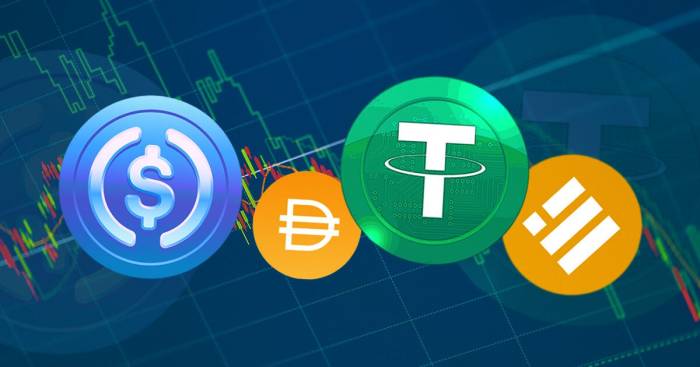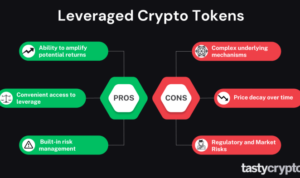Kicking off with The Potential for Stablecoins in Global Finance, this topic dives into the revolutionary impact of stablecoins on the global financial landscape. From stability to efficiency, we’re about to explore it all.
The Potential for Stablecoins in Global Finance

Stablecoins are a type of cryptocurrency that are designed to have a stable value by being pegged to a reserve asset, such as a fiat currency like the US dollar or a commodity like gold. This makes them different from other cryptocurrencies like Bitcoin or Ethereum, which can have highly volatile prices.
Examples of Popular Stablecoins
- Tether (USDT): Pegged 1:1 to the US dollar, making it one of the most widely used stablecoins in the market.
- USD Coin (USDC): Another stablecoin pegged to the US dollar, backed by a consortium of companies to ensure transparency.
- DAI: A decentralized stablecoin pegged to the US dollar but without direct fiat reserves, instead using overcollateralization through Ethereum smart contracts.
Advantages of Stablecoins
- Stability: Stablecoins offer a reliable store of value compared to volatile cryptocurrencies, making them ideal for everyday transactions.
- Speed: Transactions with stablecoins can be processed quickly due to their digital nature, enabling faster cross-border payments.
- Cost-effectiveness: Using stablecoins for remittances and international transfers can reduce fees and eliminate the need for intermediaries, cutting costs for users.
Potential Impact on Cross-Border Payments
Stablecoins have the potential to revolutionize cross-border payments by providing a more efficient and cost-effective alternative to traditional banking systems. With stablecoins, individuals and businesses can send money across borders quickly and securely without the need for banks or expensive transfer services. This can improve financial inclusion for people in underserved regions and streamline global commerce.
Stability Mechanisms of Stablecoins

Cryptocurrencies like stablecoins aim to address the issue of price volatility that is commonly associated with traditional cryptocurrencies like Bitcoin. To achieve price stability, stablecoins implement various mechanisms such as pegging to fiat currencies, commodities, or algorithms.
Pegging Mechanisms
- Fiat-collateralized stablecoins: These stablecoins are backed by fiat reserves held in a bank account. Each stablecoin issued is backed by an equivalent amount of fiat currency, ensuring a 1:1 peg to the underlying currency.
- Crypto-collateralized stablecoins: These stablecoins are backed by other cryptocurrencies held in a smart contract. The value of the collateral is typically higher than the stablecoin supply to account for price fluctuations.
- Algorithmic stablecoins: These stablecoins use algorithms to dynamically adjust the supply based on demand to maintain price stability. The algorithm automatically buys back or mints new stablecoins to regulate the price.
Challenges in Maintaining Stability, The Potential for Stablecoins in Global Finance
- Volatile crypto markets: The volatile nature of cryptocurrencies can pose challenges in maintaining stability for stablecoins, especially those pegged to volatile assets like cryptocurrencies.
- Risk of under-collateralization: In the case of crypto-collateralized stablecoins, there is a risk of the collateral value falling below the stablecoin supply, leading to potential instability.
Role of Smart Contracts and Decentralized Governance
- Smart contracts: Smart contracts play a crucial role in enforcing the rules and mechanisms governing stablecoins. They automate processes like collateral management, issuance, and redemption, increasing transparency and efficiency.
- Decentralized governance: Decentralized governance models involve community voting and decision-making processes to ensure the stability and integrity of stablecoins. This distributed approach reduces the reliance on centralized entities and enhances trust among users.
Regulatory Environment for Stablecoins
The regulatory landscape for stablecoins globally is a complex and evolving one. As these digital assets gain popularity, governments and regulatory bodies are faced with the challenge of ensuring their adoption while addressing key concerns such as anti-money laundering (AML) and know your customer (KYC) compliance, consumer protection, and systemic risks. Let’s delve into the current regulatory environment and the potential approaches governments may take to navigate these challenges.
Key Regulatory Concerns
Key regulatory concerns surrounding stablecoins revolve around AML/KYC compliance, consumer protection, and systemic risks. Ensuring that stablecoin transactions are not used for illicit purposes like money laundering or terrorist financing is crucial for regulatory bodies. Additionally, protecting consumers from fraud, operational risks, and ensuring the stability of the financial system are top priorities.
Potential Regulatory Approaches
Regulators may adopt a range of approaches to address the risks associated with stablecoins while fostering innovation. This could include implementing stringent AML/KYC requirements, setting up regulatory sandboxes to test new stablecoin projects, or developing specific guidelines for stablecoin issuers to follow. Balancing innovation and risk mitigation will be key for regulators moving forward.
Global Regulatory Landscape
Some countries have taken progressive approaches towards regulating stablecoins, providing clarity for market participants and promoting innovation. For example, Switzerland has established a clear regulatory framework for stablecoins, making it a favorable location for stablecoin projects. On the other hand, countries like China have imposed stricter regulations on stablecoins, citing concerns over financial stability and control.
Use Cases and Adoption Trends of Stablecoins: The Potential For Stablecoins In Global Finance

Stablecoins have gained popularity not only as a means of payment but also for a variety of other use cases in the financial industry. Let’s explore the diverse applications and adoption trends of stablecoins.
Decentralized Finance (DeFi)
Decentralized Finance, or DeFi, has been a major driving force behind the adoption of stablecoins. These digital assets are used as collateral, liquidity providers, and trading pairs in various DeFi platforms, enabling users to access financial services without traditional intermediaries.
Remittances
Stablecoins are increasingly being used for cross-border remittances due to their speed, low cost, and stability compared to traditional fiat currencies. Companies and individuals are leveraging stablecoins to send and receive funds across borders seamlessly.
Tokenized Assets
Another prominent use case for stablecoins is the tokenization of assets such as real estate, commodities, and securities. By representing these assets on the blockchain through stablecoins, ownership can be easily transferred, fractionalized, and traded with increased efficiency and transparency.
Case Studies
Companies like Paxos and Circle have successfully implemented stablecoins for various financial operations, reducing costs and increasing transaction speeds. Industries such as e-commerce, gaming, and supply chain management are also exploring the benefits of stablecoin adoption for improved efficiency.
Adoption Trends
The adoption of stablecoins is growing globally, with regions like Asia leading the way in integrating these digital assets into everyday transactions. Stablecoins are gaining traction in emerging markets where access to traditional banking services is limited, showcasing their potential for mainstream acceptance.
Bridge Between Traditional Finance and Digital Asset Economy
Stablecoins play a crucial role in bridging the gap between traditional financial systems and the emerging digital asset economy. By offering stability, security, and efficiency, stablecoins have the potential to revolutionize the way we transact and store value in a rapidly evolving financial landscape.





